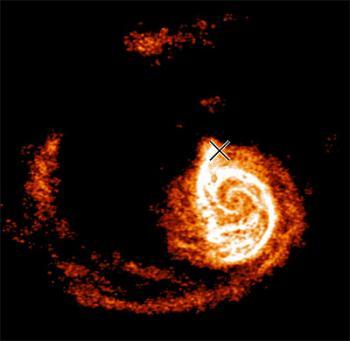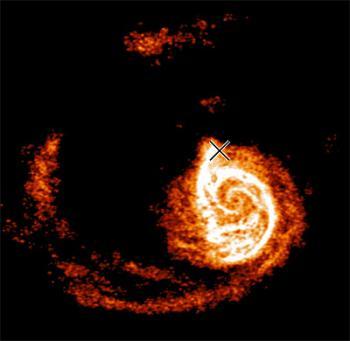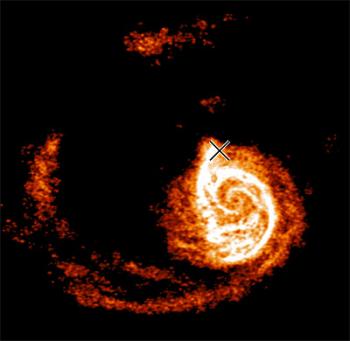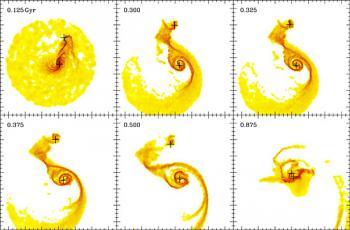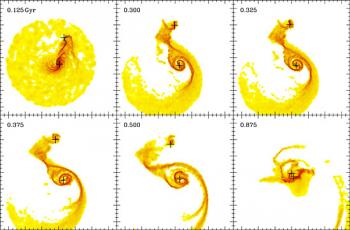Galaxy-X is about 260,000 light-years from here. It’s dominated by dark matter and is 1 percent the mass of our Milky Way galaxy, but still ranks third largest out of our galaxy’s satellite friends.
These are the predictions of theoretical astronomer Sukanya Chakrabarti, from the University of California, Berkeley, and her colleagues, presented at the American Astronomical Society meeting in Seattle, on Thursday.
Galaxy-X has gone unnoticed until now, not because of its status as a dwarf galaxy, but because it lies in the same plane as the Milky Way disc; gas and dust clouds obscure it from telescopes.
Another reason is Galaxy-X may be composed mostly of dark matter. Dark matter is believed to comprise 85 percent of all matter in the universe. Invisible to the naked eye, it can only be detected by the effects of its gravitational tide.
This gravitational pull was indispensable in detecting Galaxy-X—the ripples in gases on the edge of the Milky Way enabled Chakrabarti et al. to predict its existence.
Chakrabarti employed a method similar to that used more than 150 years ago in the discovery of Neptune, which was detected by wobbles its gravity induced in Uranus’s orbit.
The method involves analyzing gravitational perturbations in gases on the fringes of the Milky Way.
It’s speculated that if Galaxy-X exists, it will also be comprised of some other elements such as some dim stars, which “should provide enough light for astronomers to see it, now that they know where to look,” Chakrabarti told the National Geographic.
Galaxy-X has gone unnoticed until now, not because of its status as a dwarf galaxy, but because it lies in the same plane as the Milky Way disc; gas and dust clouds obscure it from telescopes.
Another reason is Galaxy-X may be composed mostly of dark matter. Dark matter is believed to comprise 85 percent of all matter in the universe. Invisible to the naked eye, it can only be detected by the effects of its gravitational tide.
This gravitational pull was indispensable in detecting Galaxy-X—the ripples in gases on the edge of the Milky Way enabled Chakrabarti et al. to predict its existence.
Chakrabarti employed a method similar to that used more than 150 years ago in the discovery of Neptune, which was detected by wobbles its gravity induced in Uranus’s orbit.
The method involves analyzing gravitational perturbations in gases on the fringes of the Milky Way.
It’s speculated that if Galaxy-X exists, it will also be comprised of some other elements such as some dim stars, which “should provide enough light for astronomers to see it, now that they know where to look,” Chakrabarti told the National Geographic.
If Galaxy-X is located, there’s hope that more dwarf satellite galaxies orbiting the Milky Way will also be detected and confirmed via Chakrabarti’s technique—what she calls “a new method to render dark galaxies visible.”
This is good news because hundreds of galaxies have been hypothesized, but only a few dozen have been found to date, and the “missing satellite problem” is one of the leading issues in cosmology today, Chakrabarti said, according to the BBC.
“This approach has broad implications for many fields of physics and astronomy—for the indirect detection of dark matter as well as dark-matter dominated dwarf galaxies, planetary dynamics, and for galaxy evolution driven by satellite impacts,” Chakrabarti said in a University of California, Berkeley press release.
“Our paper is a proof of principle, but we need to look at a much larger sample of spiral galaxies with optically visible galactic companions to determine the incidence of false positives,” and thus the method’s reliability, she added.
So now it’s just a question of whether Galaxy-X can be hunted down. Chakrabarti plans to spend time looking via a large infrared telescope.
But if it can’t be found, that will pose more questions. Chakrabarti says it would mean there are some other phenomena causing calculations to go amiss, according to the National Geographic.
The Galaxy X study is published in arXiv.org.
This is good news because hundreds of galaxies have been hypothesized, but only a few dozen have been found to date, and the “missing satellite problem” is one of the leading issues in cosmology today, Chakrabarti said, according to the BBC.
“This approach has broad implications for many fields of physics and astronomy—for the indirect detection of dark matter as well as dark-matter dominated dwarf galaxies, planetary dynamics, and for galaxy evolution driven by satellite impacts,” Chakrabarti said in a University of California, Berkeley press release.
“Our paper is a proof of principle, but we need to look at a much larger sample of spiral galaxies with optically visible galactic companions to determine the incidence of false positives,” and thus the method’s reliability, she added.
So now it’s just a question of whether Galaxy-X can be hunted down. Chakrabarti plans to spend time looking via a large infrared telescope.
But if it can’t be found, that will pose more questions. Chakrabarti says it would mean there are some other phenomena causing calculations to go amiss, according to the National Geographic.
The Galaxy X study is published in arXiv.org.
